Molecular Dynamics Simulation on the Diffusion of Flavor, O2 and H2O Molecules in LDPE Film
Abstract
:1. Introduction
2. Materials and Methods
2.1. Materials
2.2. Film Adsorption Experiment
2.3. GC-MS Analysis Conditions
2.4. Data Analysis
3. Molecular Simulation Details
3.1. Modeling
3.2. Simulations
4. Results and discussions
4.1. Interaction Energy between Diffusion Molecules and PE Chain
4.2. Diffusion Coefficient (D)
4.2.1. Calculation of D by Prediction Model
4.2.2. Experimental Determination of D
4.2.3. Molecular Simulation Results
4.2.4. Comparison among Experiment, Prediction Model and MD Simulation Results
4.3. Fraction of Free Volume
4.4. Diffusion of O2 and H2O in PE before and after Adsorption
5. Conclusions
Author Contributions
Funding
Conflicts of Interest
References
- Fu, Y.C.; Lim, L.T. Investigation of multiple-component diffusion through LLDPE film using an FTIR-ATR technique. Polym. Test. 2012, 31, 56–67. [Google Scholar] [CrossRef]
- Júnior, L.M.; Cristianini, M.; Padula, M.; Anjos, C.A.R. Effect of high-pressure processing on characteristics of flexible packaging for foods and beverages. Food Res. Int. 2019, 119, 920–930. [Google Scholar] [CrossRef] [PubMed]
- Lu, L.X.; Sun, Y.C.; Tang, Y.L.; Liu, Z.G.; Wang, J. Effects of flavor compounds concentrations and external temperatures on absorption by LDPE. J. Food Sci. Biotechnol. 2016, 35, 635–639. [Google Scholar]
- Brody, A.L. Flavor scalping: Quality loss due to packaging. Food Technol. 2002, 56, 124–125. [Google Scholar]
- Ros-Chumillas, M.; Belissario, Y.; Iguaz, A.; López, A. Quality and shelf life of orange juice aseptically packaged in PET bottles. J. Food Eng. 2007, 79, 234–242. [Google Scholar] [CrossRef]
- Lozano, P.R.; Drake, M.; Bentez, D.; Cadwallader, K.R. Instrumental and sensory characterization of heat-induced odorants in aseptically packaged soy milk. J. Agric. Food Chem. 2007, 55, 3018–3026. [Google Scholar] [CrossRef] [PubMed]
- Farhoodi, M.; EmamDjomeh, Z.; Falah, A. Effect of menthol absorption by packaging material on the quality of yogurt drink during storage time. J. Agric. Sci. Technol. 2013, 15, 1373–1380. [Google Scholar]
- Lloyd, M.A.; Hess, S.J.; Drake, M.A. Effect of nitrogen flushing and storage temperature on flavor and shelf-life of whole milk powder. J. Dairy Sci. 2009, 92, 2409–2422. [Google Scholar] [CrossRef]
- Caner, C. Sorption phenomena in packaged foods: Factors affecting sorption processes in package-product systems. Packag. Technol. Sci. 2011, 24, 259–270. [Google Scholar] [CrossRef]
- Sun, Y.C.; Lu, L.X. Effect of flavor compound kinds on absorption behavior of LDPE film. Packag. Eng. 2013, 34, 34–37. [Google Scholar]
- Dias, M.V.; Medeiros, H.S.; Soares, N.F.F.; Melo, N.R.; Borges, S.V.; Carneiro, J.D.S.; de Assis Kluge Pereira, J.M.T. Development of low-density polyethylene films with lemon aroma. Food Sci. Technol. 2013, 50, 167–171. [Google Scholar] [CrossRef] [Green Version]
- Petrus, R.R.; Walter, E.H.M.; Faria, J.A.F.; Abreu, L.F. Sensory stability of ultra-high temperature milk in polyethylene bottle. J. Food Sci. 2009, 74, 53–57. [Google Scholar] [CrossRef] [PubMed]
- Mauricio-Iglesias, M.; Peyron, S.; Chalier, P.; Gontard, N. Scalping of four aroma compounds by one common (LDPE) and one biosourced (PLA) packaging materials during high pressure treatments. J. Food Eng. 2011, 102, 9–15. [Google Scholar] [CrossRef]
- Johansson, F.; Leufvén, A. Concentration and interactive effects on the sorption of aroma liquids and vapors into polypropylene. J. Food Sci. 1997, 62, 355–358. [Google Scholar] [CrossRef]
- Bacigalupi, C.; Lemaistre, M.H.; Boutroy, N.; Bunel, C.; Peyron, S.; Guillard, V.; Chalier, P. Changes in nutritional and sensory properties of orange juice packed in PET bottles: An experimental and modelling approach. Food Chem. 2013, 141, 3827–3836. [Google Scholar] [CrossRef]
- Peychès-Bach, A.; Moutounet, M.; Peyron, S.; Chalier, P. Factors determining the transport coefficients of aroma compounds through polyethylene films. J. Food Eng. 2009, 95, 45–53. [Google Scholar] [CrossRef]
- Cava, D.; Catala, R.; Gavara, R.; Lagaron, J.M. Testing limonene diffusion through food contact polyethylene by FT-IR spectroscopy: Film thickness, permeant concentration and outer medium effects. Polym. Test. 2005, 24, 483–489. [Google Scholar] [CrossRef]
- Suppakul, P.; Sonneveld, K.; Bigger, S.W.; Miltz, J. Diffusion of linalool and methylchavicol from polyethylene-based antimicrobial packaging films. Food Sci. Tech. 2011, 44, 1888–1893. [Google Scholar] [CrossRef] [Green Version]
- Limam, M.; Tighzert, L.; Fricoteaux, F.; Bureau, G. Sorption of organic solvents by packaging materials: Polyethylene terephthalate and TOPAS. Polym. Test. 2005, 24, 395–402. [Google Scholar] [CrossRef]
- Dury-Brun, C.; Fournier, N.; Pernin, K.; Guichard, E.; Voilley, A. A new approach to studying sponge cake aroma after storage in treated paper and plastic packaging by direct gas chromatography- olfactometry (D-GC-O). Flavour Fragr. J. 2007, 22, 255–264. [Google Scholar] [CrossRef]
- Xu, Y.; Liu, Y.L.; He, D.D.; Liu, G.S. Adsorption of cationic collectors and water on muscovite (001) surface: A molecular dynamics simulation study. Miner. Eng. 2013, 53, 101–107. [Google Scholar] [CrossRef]
- Feenstraa, P.; Brunsteiner, M.; Khinast, J. Prediction of drug-packaging interactions via molecular dynamics (MD) simulations. Int. J. Pharm. 2012, 431, 26–32. [Google Scholar] [CrossRef] [PubMed]
- Moyassari, A.; Gkourmpis, T.; Hedenqvist, M.S.; Gedde, U.W. Molecular dynamics simulation of linear polyethylene blends: Effect of molar mass bimodality on topological characteristics and mechanical behavior. Polymer 2019, 161, 139–150. [Google Scholar] [CrossRef]
- Paajanen, A.; Vaari, J.; Verho, T. Crystallization of cross-linked polyethylene by molecular dynamics simulation. Polymer 2019, 171, 80–86. [Google Scholar] [CrossRef]
- Gee, R.H.; Boyd, R.H. The role of the torsional potential in relaxation dynamics: A molecular dynamics study of polyethylene. Comput. Theor. Polym. Sci. 1998, 8, 93–98. [Google Scholar] [CrossRef]
- Börjessona, A.; Erdtman, E.; Ahlström, P.; Berlin, M.; Andersson, T.; Bolton, K. Molecular modelling of oxygen and water permeation in polyethylene. Polymer 2013, 54, 2988–2998. [Google Scholar] [CrossRef] [Green Version]
- Yue, Y.J.; Liu, Q.Z.; Wu, L.Y.; Hu, Y.D. Molecular dynamics simulation for diffusion of organic molecules in polyethylene membranes. CIESC J. 2012, 63, 109–113. [Google Scholar]
- Wang, P.L.; Wang, Z.W.; Hu, C.Y.; Chen, M. Molecular dynamics simulation of diffusion coefficients of small molecules in amorphous PET. CIESC J. 2009, 60, 1920–1925. [Google Scholar]
- Tao, C.G.; Feng, H.J.; Zhou, J.; Lü, L.H.; Lu, X.H. Molecular simulation of oxygen adsorption and diffusion in polypropylene. Acta Phys.-Chim. Sin. 2009, 25, 1373–1378. [Google Scholar]
- Cíhal, P.; Vopička, O.; Pilnáček, K.; Poustka, J.; Friess, K.; Hajšlová, J.; Dobiáš, J.; Dole, P. Aroma scalping characteristics of polybutylene succinate based films. Polym. Test. 2015, 46, 108–115. [Google Scholar] [CrossRef]
- Hambleton, A.; Voilley, A.; Debeaufort, F. Transport parameters for aroma compounds through i-carrageenan and sodium alginate-based edible films. Food Hydrocoll. 2011, 25, 1128–1133. [Google Scholar] [CrossRef]
- Follain, N.; Valleton, J.M.; Lebrun, L.; Alexandre, B.; Schaetzel, P.; Metayer, M.; Marais, S. Simulation of kinetic curves in mass transfer phenomena for a concentration-dependent diffusion coefficient in polymer membranes. J. Membr. Sci. 2010, 349, 195–207. [Google Scholar] [CrossRef]
- Ibarra, V.G.; Quirós, A.R.B.; Losada, P.P.; Sendón, R. Non-target analysis of intentionally and non intentionally added substances from plastic packaging materials and their migration into food simulants. Food Packag. Shelf. 2019, 21, 100325. [Google Scholar] [CrossRef]
- Guo, X.; Liu, Y.; Wang, J.L. Sorption of sulfamethazine onto different types of microplastics: A combined experimental and molecular dynamics simulation study. Mar. Pollut. Bull. 2019, 145, 547–554. [Google Scholar] [CrossRef] [PubMed]
- Harami, H.R.; Fini, F.R.; Rezakazemi, M.; Shirazian, S. Sorption in mixed matrix membranes: Experimental and molecular dynamic simulation and Grand Canonical Monte Carlo method. J. Mol. Liq. 2019, 282, 566–576. [Google Scholar] [CrossRef]
- Saha, S.; Bhowmick, A.K. An Insight into molecular structure and properties of flexible amorphous polymers: A molecular dynamics simulation approach. J. Appl. Polym. Sci. 2019, 136, 47457. [Google Scholar] [CrossRef]
- Demontis, P.; Fois, E.; Suffritti, G.B.; Quartieri, S. Molecular dynamics studies on zeolites. 4. Diffusion of methane in silicalite. J. Phys. Chem. 1990, 94, 4329–4334. [Google Scholar] [CrossRef]
- Demontis, P.; Suffritti, G.B.; Fois, E.; Quartieri, S. Molecular dynamics studies on zeolites. 6. Temperature dependence of diffusion of methane in silicaiite. J. Phys. Chem. 1992, 96, 1482–1490. [Google Scholar] [CrossRef]
- Han, L.; Liu, K.Z.; Wang, M.H.; Fang, L.M.; Chen, H.T.; Zhou, J.; Lu, X. Mussel-inspired adhesive and conductive hydrogel with Long-lasting moisture and extreme temperature tolerance. Adv. Funct. Mater. 2018, 28, 1704195. [Google Scholar] [CrossRef]
- Meng, J.Q.; Yin, F.F.; Li, S.C.; Zhong, R.Q.; Sheng, Z.Y.; Nie, B.S. Effect of different concentrations of surfactant on the wettability of coal by molecular dynamics simulation. Int. J. Min. Sci. Technol. 2019, 29, 577–584. [Google Scholar] [CrossRef]
- Sun, B.Q.; Wang, Z.W. Analysis of diffusion coefficient for migration model in food packaging material. Packag. Eng. 2006, 27, 34–36. [Google Scholar]
- Brandsch, J.; Mercea, P.; Rüter, M.; Tosa, V.; Piringer, O. Migration modelling as a tool for quality assurance of food packaging. Food Addit. Contam. A 2002, 19, 29–41. [Google Scholar] [CrossRef] [PubMed]
- Piringer, O.G.; Baner, A.L. Food Plastic Packaging Material: Barrier Function, Mass Transfer, Quality Assurance and Legislation; Chemical Industry Press: Beijing, China, 2004; pp. 396–397. [Google Scholar]
- Fertikh, N.; Toubal, A.; Larbi, L.; Messadi, D.; Duprat, F. Sorption and diffusion of flavours contained in rose-water in plastic packaging. IJETS 2013, 1, 149–162. [Google Scholar]
- Laoubi, S.; Vergnaud, J.M. Food sandwich packaging with a recycled polymer between two functional barriers of different thicknesses. Polym. Test. 1996, 15, 269–279. [Google Scholar] [CrossRef]
- Wang, Z.H.; Xin, Y. Molecular dynamics simulation on the relationship of oxygen diffusion and polymer chains activity. Mater. Rep. 2019, 33, 1293–1297. [Google Scholar]
- Reynier, A.; Dole, P.; Humbel, S.; Feigenbaum, A. Diffusion coefficients of additives in polymers. I. Correlation with geometric parameters. J. Appl. Polym. Sci. 2001, 82, 2422–2433. [Google Scholar] [CrossRef]
- Reynier, A.; Dole, P.; Feigenbaum, A. Additive diffusion coefficients in polyolefins. II. Effect of swelling and temperature on the D = f(M) correlation. J. Appl. Polym. Sci. 2001, 82, 2434–2443. [Google Scholar] [CrossRef]
- Müller-Plathe, F.; Rogers, S.C.; Gunsteren, W.F. Computational evidence for anomalous diffusion of small molecules in amorphous polymers. Chem. Phys. Lett. 1992, 199, 237–243. [Google Scholar] [CrossRef]
- Wang, Z.W.; Wang, P.L.; Hu, C.Y. Molecular dynamics simulation on diffusion of 13 kinds of small molecules in polyethylene terephthalate. Packag. Technol. Sci. 2010, 23, 457–469. [Google Scholar] [CrossRef]
- Mei, L.Y.; Liao, L.Q.; Fu, Y.Z.; Zhang, M.Y.; Liu, Y.Q. Molecular dynamics simulations of diffusion coefficients of small molecules in PET/PLA blends. Polym. Mater. Sci. Eng. 2012, 28, 179–182 + 186. [Google Scholar]
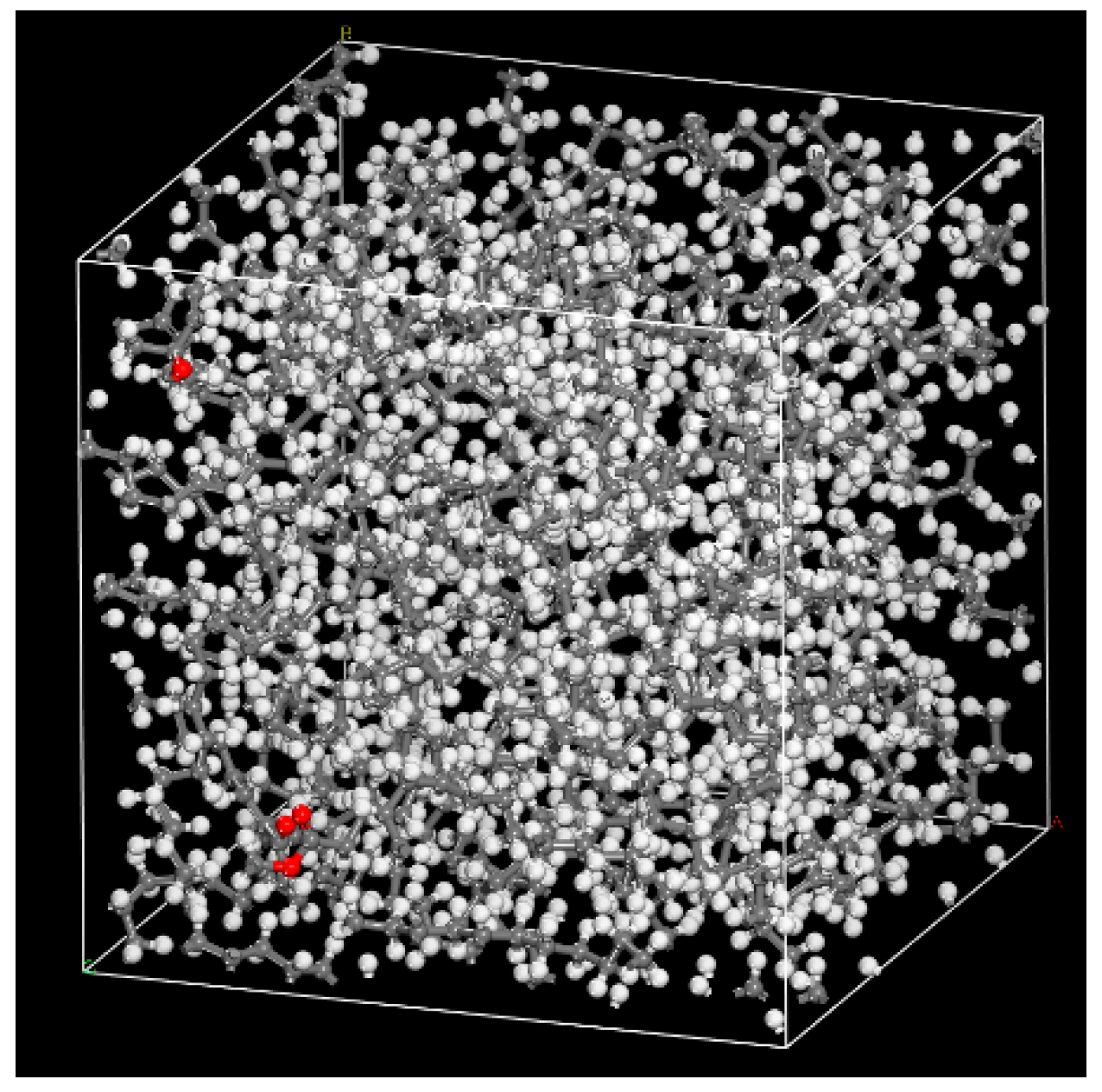
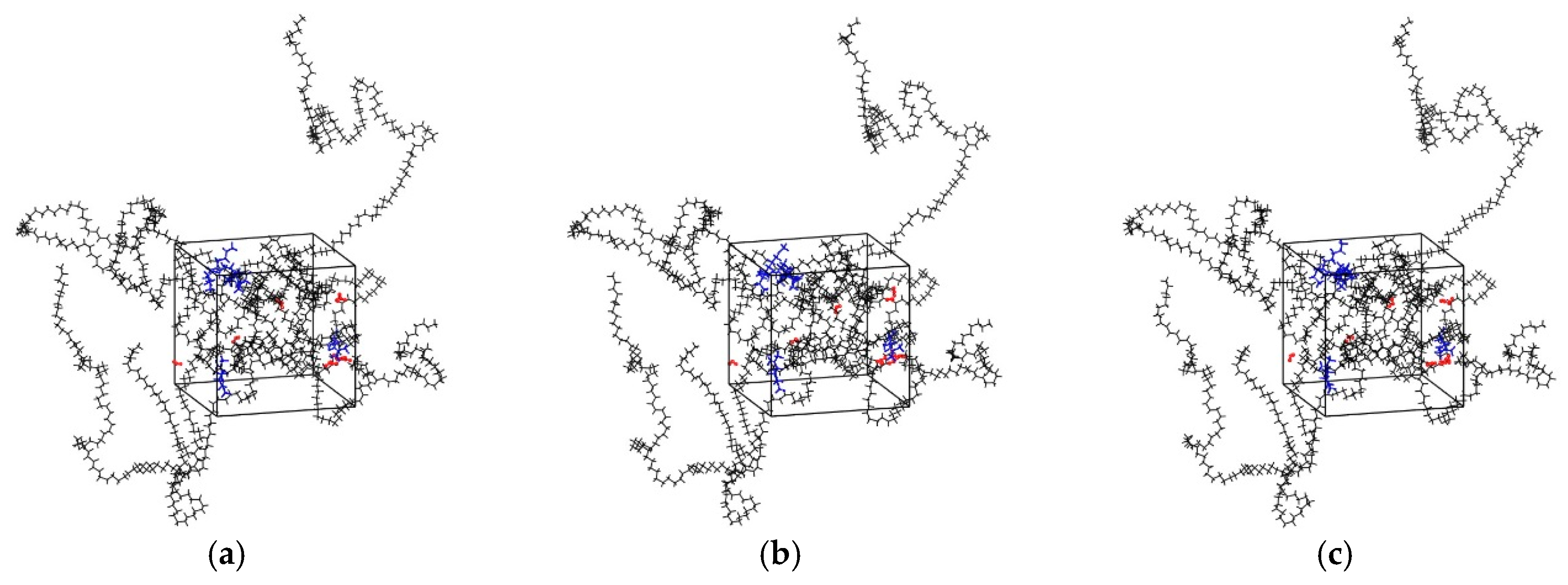
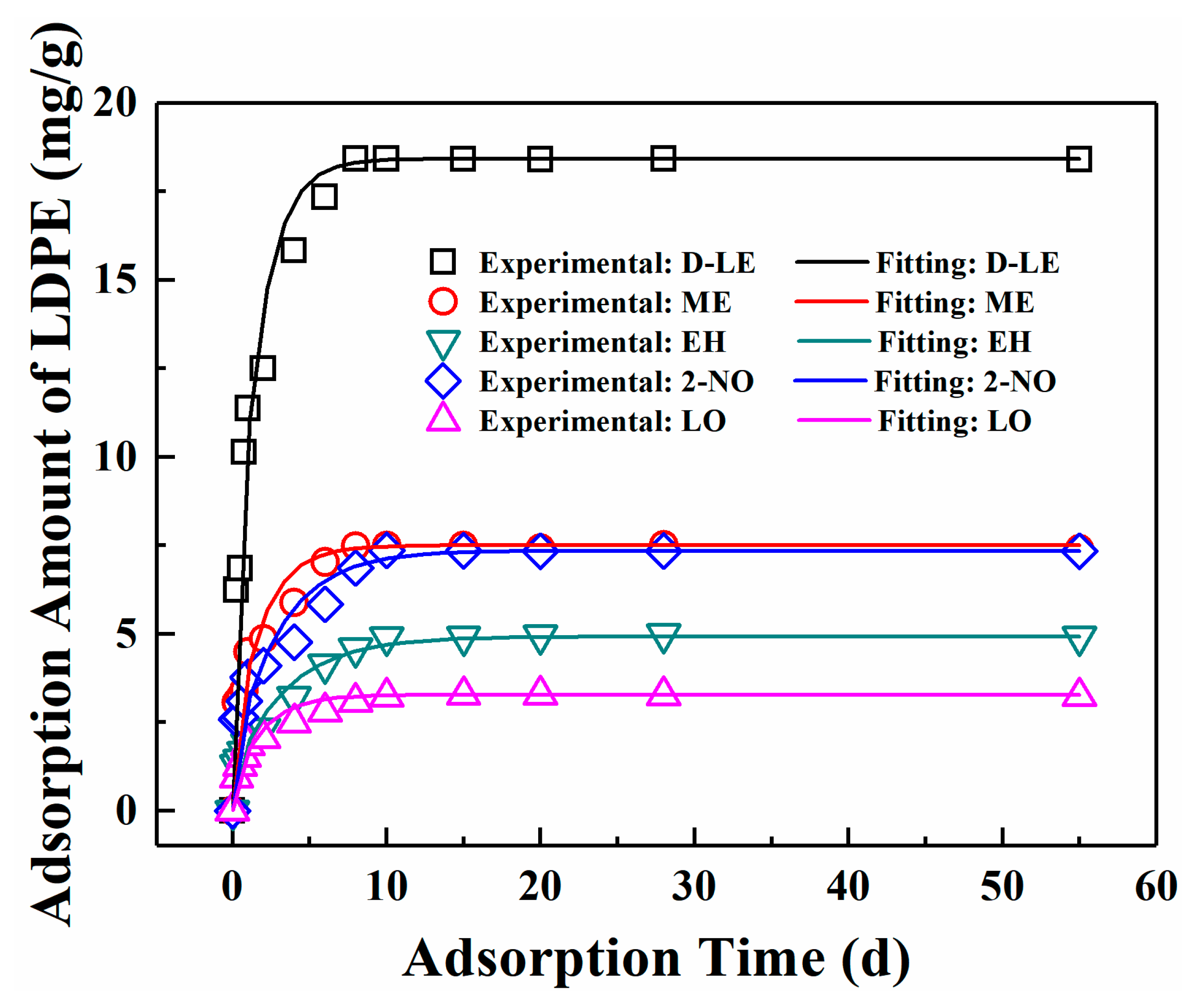
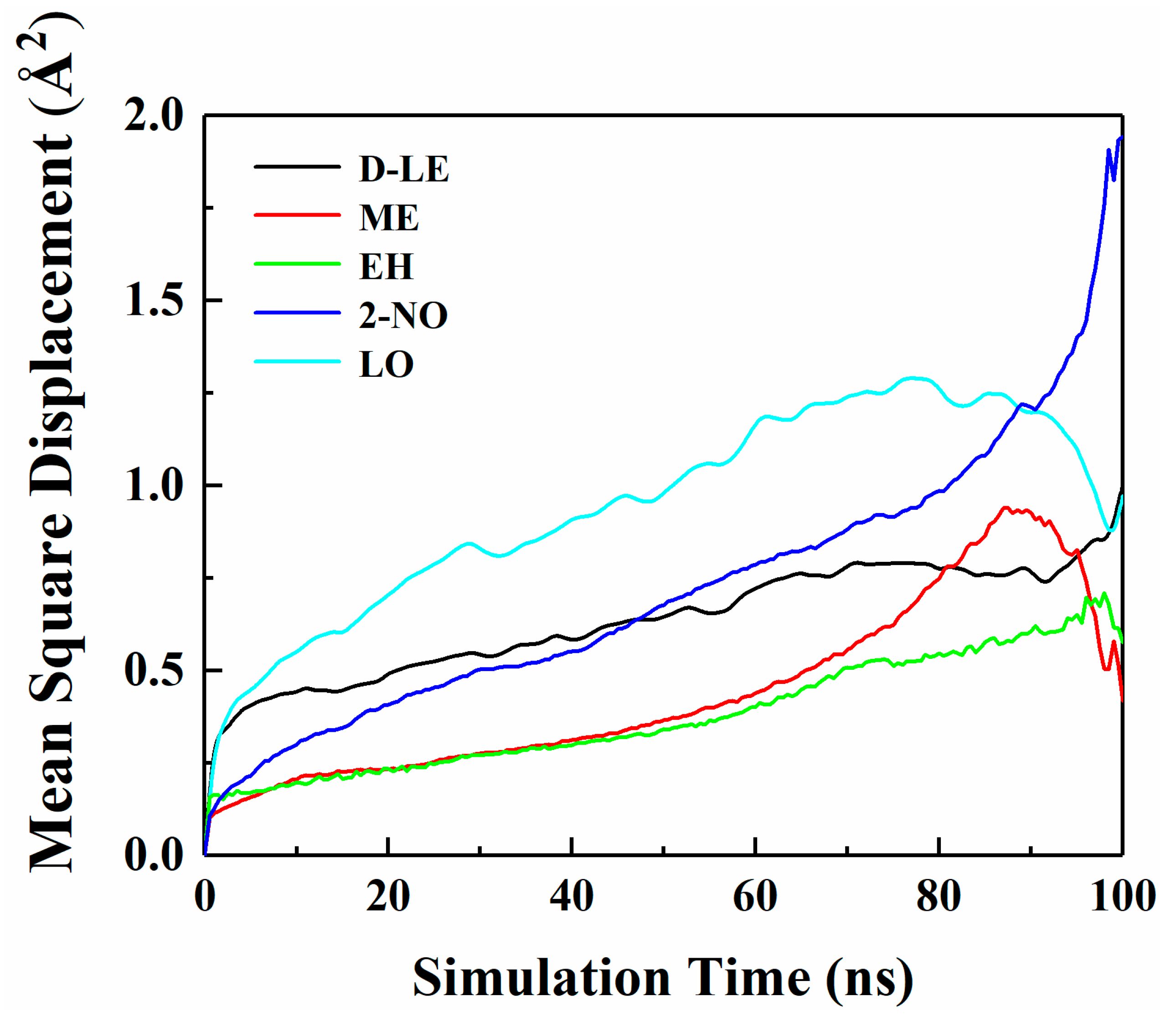

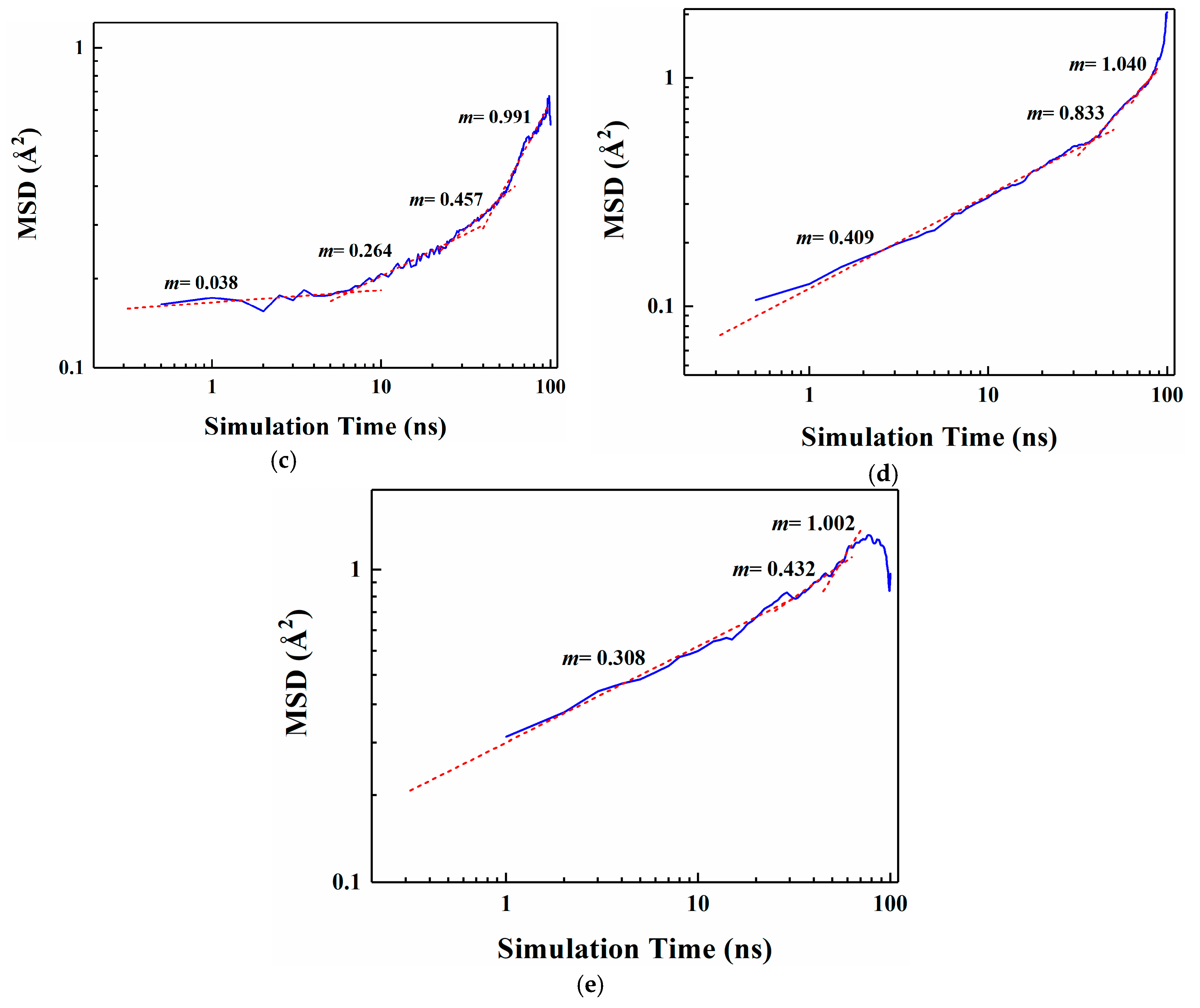
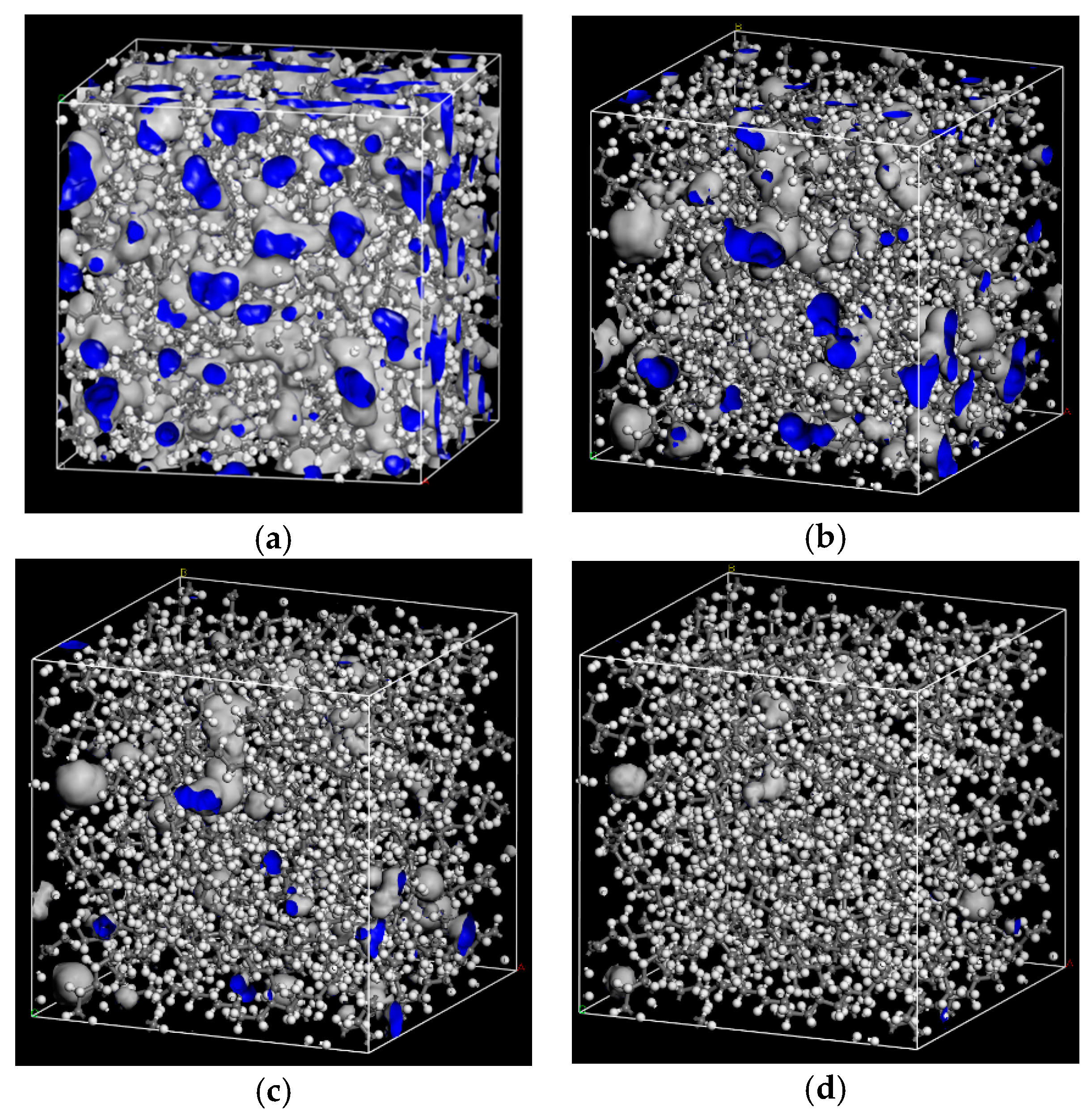
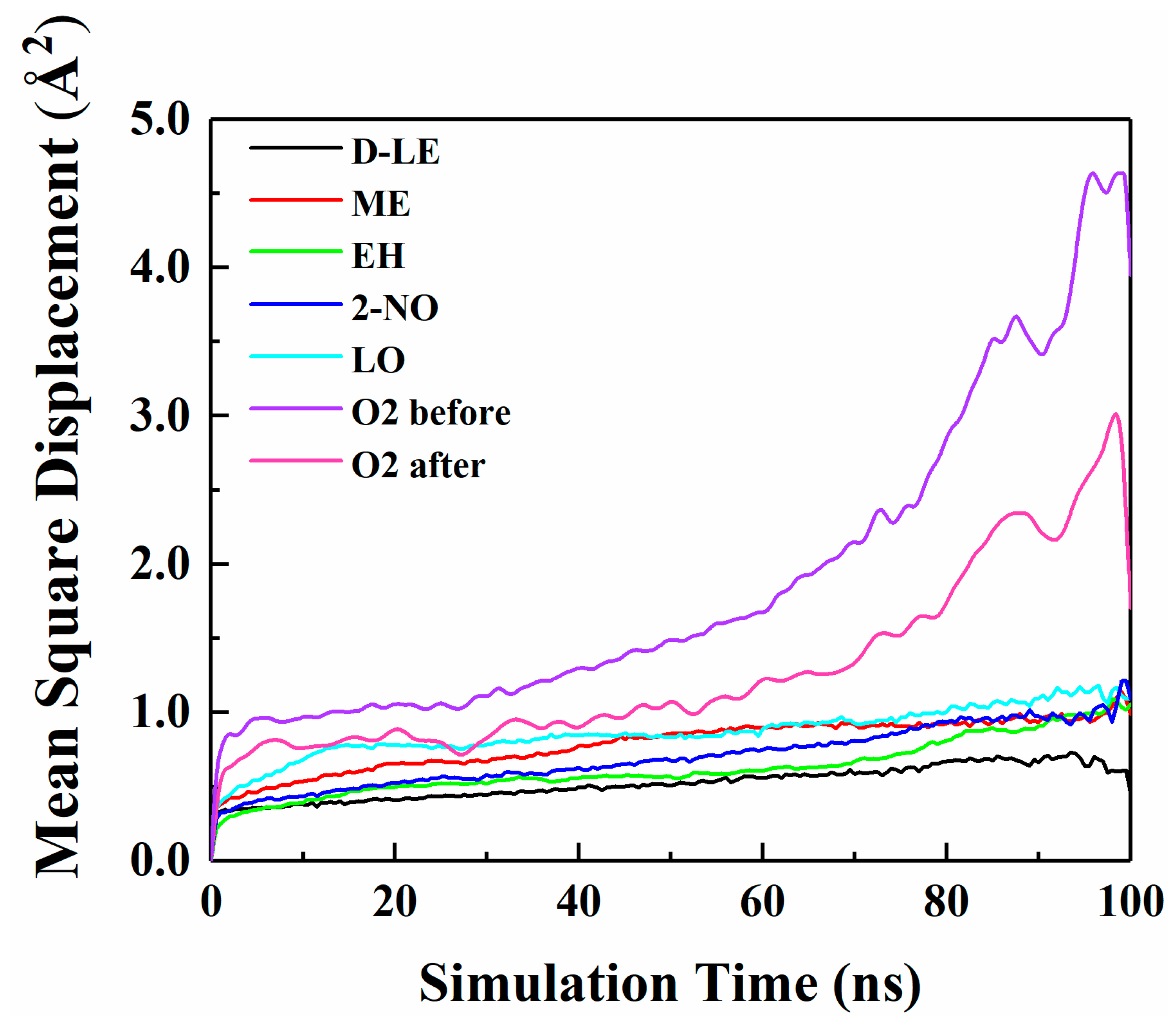
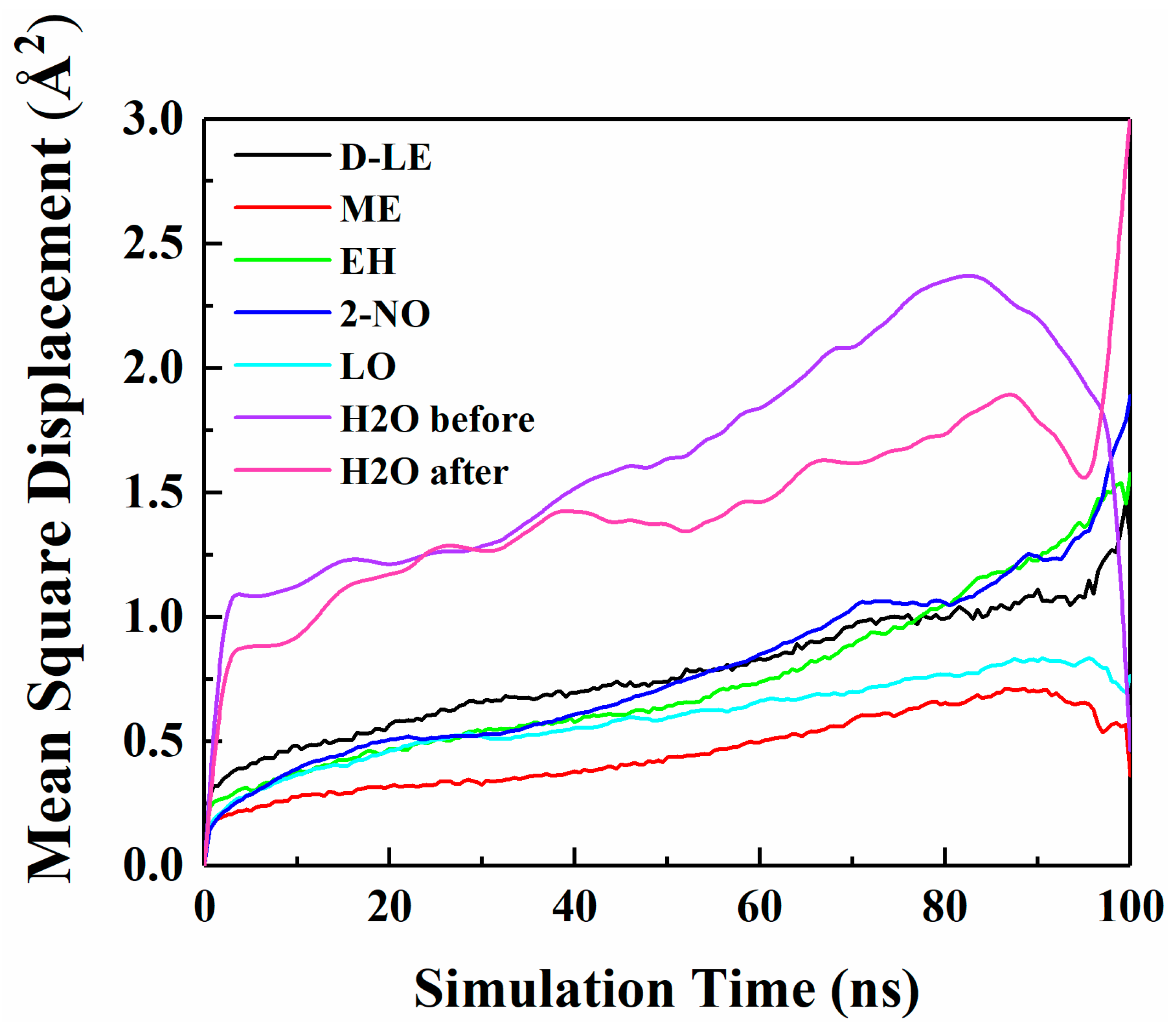
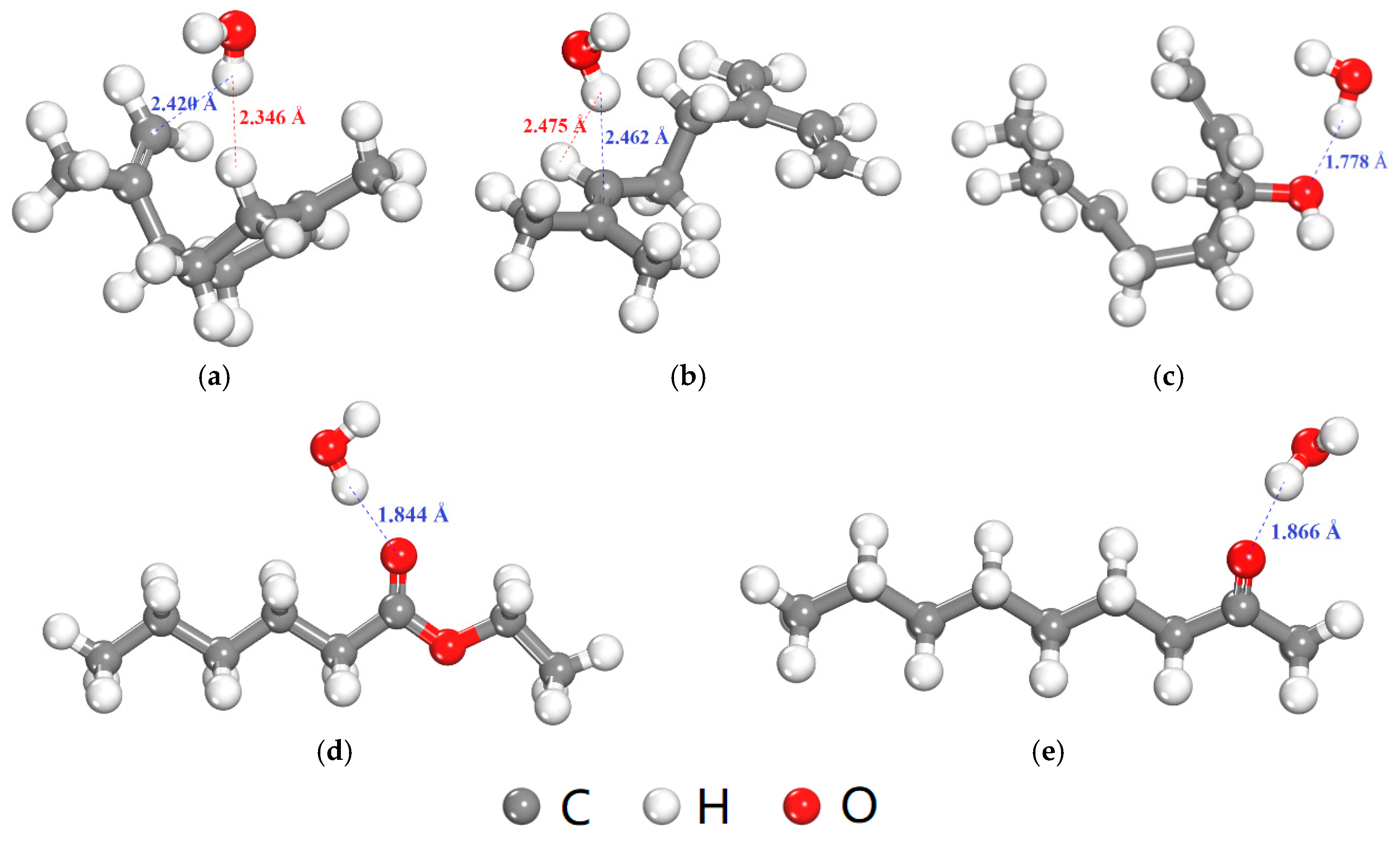
| Model | Composition | |||||||
|---|---|---|---|---|---|---|---|---|
| PE160 | D-LE | ME | EH | 2-NO | LO | O2 | H2O | |
| PE + flavor | 3 | 1 | 1 | 1 | 1 | 1 | 0 | 0 |
| PE + O2 | 3 | 0 | 0 | 0 | 0 | 0 | 3 | 0 |
| PE + H2O | 3 | 0 | 0 | 0 | 0 | 0 | 0 | 10 |
| PE + flavor + O2 | 3 | 1 | 1 | 1 | 1 | 1 | 3 | 0 |
| PE + flavor + H2O | 3 | 1 | 1 | 1 | 1 | 1 | 0 | 10 |
| Molecules | Eint (kcal/mol) with PE Chain |
|---|---|
| D-limonene | −1.45 |
| Myrcene | −1.98 |
| Ethyl hexanoate | −2.00 |
| 2-nonanone | −1.88 |
| Linalool | −2.96 |
| O2 | −0.83 |
| H2O | −0.25 |
| Flavor Molecules | Mr | Dpre (cm2/s) |
|---|---|---|
| D-limonene | 136.24 | 1.91 × 10−8 |
| Myrcene | 136.23 | 1.91 × 10−8 |
| Ethyl hexanoate | 144.21 | 1.70 × 10−8 |
| 2-nonanone | 142.24 | 1.75 × 10−8 |
| Linalool | 154.25 | 1.48 × 10−8 |
| Flavor Molecules | Dexp (cm2/s) | R2 |
|---|---|---|
| D-limonene | (6.69 ± 1.63) × 10−11 | 0.98 |
| Myrcene | (5.72 ± 2.18) × 10−11 | 0.96 |
| Ethyl hexanoate | (3.08 ± 1.14) × 10−11 | 0.99 |
| 2-nonanone | (3.50 ± 2.15) × 10−11 | 0.95 |
| Linalool | (5.41 ± 2.54) × 10−11 | 0.97 |
| Molecules | Dpre (cm2/s) | Dsim (cm2/s) | Dexp (cm2/s) | Dpre/Dexp | Dsim/Dexp |
|---|---|---|---|---|---|
| D-limonene | 1.91 × 10−8 | (9.31 ± 0.24) × 10−11 | (6.69 ± 1.63) × 10−11 | 286 | 1.39 |
| Myrcene | 1.91 × 10−8 | (7.90 ± 0.13) × 10−11 | (5.72 ± 2.18) × 10−11 | 334 | 1.38 |
| Ethyl hexanoate | 1.70 × 10−8 | (6.90 ± 0.13) × 10−11 | (3.08 ± 1.14) × 10−11 | 552 | 2.24 |
| 2-nonanone | 1.75 × 10−8 | (1.56 ± 0.02) × 10−10 | (3.50 ± 2.15) × 10−11 | 500 | 4.46 |
| Linalool | 1.48 × 10−8 | (1.72 ± 0.04) × 10−10 | (5.41 ± 2.54) × 10−11 | 274 | 3.18 |
| RP | 1 Å | 1.5 Å | 2 Å | 2.7 Å |
|---|---|---|---|---|
| FFV (%) | 18.53 | 7.70 | 2.58 | 0.46 |
| Molecules | Dbefore (cm2/s) | Dafter (cm2/s) |
|---|---|---|
| O2 | 4.04 × 10−10 | 2.38 × 10−10 |
| H2O | 2.93 × 10−10 | 1.12 × 10−10 |
| Form | PE | PE + O2 | PE + H2O |
|---|---|---|---|
| FFV (%) before adsorption | 18.49 | 17.92 | 19.75 |
| FFV (%) after adsorption | 17.18 | 16.42 | 17.68 |
| Flavor Molecules | Eint (kcal/mol) with O2 | Eint (kcal/mol) with H2O |
|---|---|---|
| D-limonene | −1.01 | −2.42 |
| Myrcene | −1.06 | −1.85 |
| Ethyl hexanoate | −0.72 | −4.74 |
| 2-nonanone | −0.91 | −5.52 |
| Linalool | −0.60 | −6.67 |
© 2019 by the authors. Licensee MDPI, Basel, Switzerland. This article is an open access article distributed under the terms and conditions of the Creative Commons Attribution (CC BY) license (http://creativecommons.org/licenses/by/4.0/).
Share and Cite
Sun, B.; Lu, L.; Zhu, Y. Molecular Dynamics Simulation on the Diffusion of Flavor, O2 and H2O Molecules in LDPE Film. Materials 2019, 12, 3515. https://doi.org/10.3390/ma12213515
Sun B, Lu L, Zhu Y. Molecular Dynamics Simulation on the Diffusion of Flavor, O2 and H2O Molecules in LDPE Film. Materials. 2019; 12(21):3515. https://doi.org/10.3390/ma12213515
Chicago/Turabian StyleSun, Binqing, Lixin Lu, and Yong Zhu. 2019. "Molecular Dynamics Simulation on the Diffusion of Flavor, O2 and H2O Molecules in LDPE Film" Materials 12, no. 21: 3515. https://doi.org/10.3390/ma12213515
APA StyleSun, B., Lu, L., & Zhu, Y. (2019). Molecular Dynamics Simulation on the Diffusion of Flavor, O2 and H2O Molecules in LDPE Film. Materials, 12(21), 3515. https://doi.org/10.3390/ma12213515





